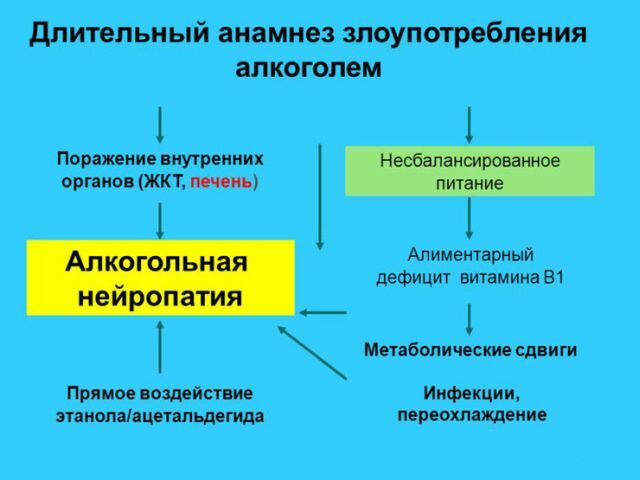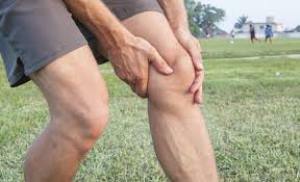 The internal popliteal nerve( medial sciatic nerve) is the proximal part of the tibial nerve, which in turn is the continuation of the sciatic, largest nerve of the human body.
The internal popliteal nerve( medial sciatic nerve) is the proximal part of the tibial nerve, which in turn is the continuation of the sciatic, largest nerve of the human body.
The sciatic nerve innervates the muscles of the dorsal surface of the thigh, that is, it helps to bend the knee and ends with two large branches in the popliteal fossa - tibial and peroneal. The proximal part of the tibial nerve performs the following functions:
- due to the presence of collateral branches promotes motor innervation and sensitivity of the muscles of the back of the tibia, that is, the ankle extension and flexion of the toes;
- the medial plantar and lateral plantar branches of the terminating the median popliteal nerve provide innervation of the soles of the soles, thereby flexing and laterally displacing the toes.
Content
- Types of nerve injuries
- What triggers a destructive process
- clinical picture
- The diagnosis
- neuropathy of the median nerve
- Neuralgia popliteal nerve
- defeat neuritis
- Consequences and complications
- Preventive measures
Types of nerve injuries
defeat medial popliteal nerve is not as common in view of itslocation, and occurs usually at pre- or retirement age( up to 60 years) in persons suffering from inflammatory processesthemselves, are localized in the lumbosacral region, in patients with chronic relapsing course lyubmoishialgii, they often suffer and athletes.
The etiology of pathology development in the popliteal part of the tibial nerve is primarily associated with the following factors:
- trauma;
- is an inflammation;
- toxic effects, deformation, compression, etc.
There are three types of damage to the median nerve:
- neuralgia;
- neuritis;
- Neuropathy.
More on each type of lesion:
- The condition at which the internal popliteal nerve is squeezed( injured) is called by neuralgia .Call it
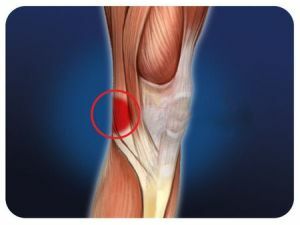 can both inflammatory and other processes occurring in the adjacent to the nerve soft tissues. The patient feels a burning or pricking pain, which is localized in the area of the ankle, extends to the toes and is strengthened when walking.
can both inflammatory and other processes occurring in the adjacent to the nerve soft tissues. The patient feels a burning or pricking pain, which is localized in the area of the ankle, extends to the toes and is strengthened when walking. - The inflammatory process that occurs in the peripheral nerves, to which the middle popliteal group belongs, is called neuritis .From neuralgia neuritis differs in that inflammation captures the nerve together with its membrane, with neuralgia, however, there is a lesion of the region of passage of nerve endings due to the irritation of many factors. Neuritis occurs with intense pain, with impaired nerve functions and changes in sensitivity.
- Another type of lesion of the mediated popliteal nerve is neuropathy .This condition can be traumatic, compression, dysmetabolic genesis. The development of pathology leads to a violation of the muscular functions of the shin, which manifests itself in the painful bending of the foot and toes. In addition to the pain syndrome, vegetative-trophic changes in the foot are observed. The risk group includes athletes and those who for a long time are forced to be in the "squatting" position.
All processes differ from one another in aetiology, course, methods of treatment, consequences.
What provokes the destructive process
The reasons for the defeat of the median popliteal nerve can be mass, besides the common ones - trauma, inflammation, squeezing, the following can be distinguished:
- slowed blood circulation due to varicose veins;
- valgus flatfoot;
- rheumatoid arthritis;
- prolonged sitting leg to leg;
- wearing excessively tight shoes;
- change in the musculoskeletal apparatus
- reflex muscular-tonic disorders due to curvature of the spine( osteochondrosis, scoliosis, spondylarthrosis);
- surgical interventions, which caused an incorrect position of the foot;
- diseases, which caused the proliferation of connective tissue( gout, polymyositis);
- metabolic disorder( diabetes, obesity);
- intoxication( alcohol, narcotic substances);
- local tumor processes.
Clinical picture
The initial stage of the pathological process is characterized by pronounced persistent and prolonged( from several months to several years) pain in the popliteal fossa, in the lower leg. Cramps in the muscles of the calves are possible, which are accompanied by a moderate intensity syndrome.
 Pain sensations can occur both at rest and during walking. With the passage of time, paresis of the lower leg and feet develops. After - there are paretic processes in the foot and muscle hypotrophy of the affected limb.
Pain sensations can occur both at rest and during walking. With the passage of time, paresis of the lower leg and feet develops. After - there are paretic processes in the foot and muscle hypotrophy of the affected limb.
The damaged side is characterized by a decrease in the Achilles reflex and an increase in the knee, a visual examination reveals swelling of the tissue in the popliteal fossa. At palpation the patient complains of dense formations in the muscles, in the locus of their attachment to the tendons, the patient can feel the densification during an independent examination.
The arterial pulse is lowered on the inner side of the foot, the patient is not allowed to fully unbend the leg due to the destruction of the muscles that are innervated by the damaged nerve. Due to the absence of the Achilles reflex, a change in sensitivity in the region of the sole and posterior surface of the tibia is observed.
Diagnosis of
Diagnosis is performed taking into account clinical and neurological data. In order to correctly diagnose the lesion, use the following sequence of methods:
- Survey ( on the state, the activities of uncomfortable sensations).
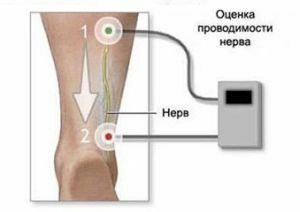
- Palpation of to identify seals.
- Examination for the detection of the muscular-stem symptom Lasega .When walking patients tend to limp on the side that is damaged due to its alleged shortening. This symptom in most patients may even appear several years after the onset of the first symptoms.
- In connection with similar manifestations of vertebrogenic pathology, doctors practice of the spine, knee joint examination by means of roentgenography .
- Additionally, the nature of the lesion is detected using ultrasound, MRI, and electromyography .
Neuropathy of the median nerve
Affected nerve endings result in impaired transmission of pulses from the central nervous system to muscle tissue, to organs. Because of this, sensitivity, motor, trophic function changes. Neuropathy can manifest itself in:
- numbness of the limb;
- tingling, burning;
- spasmodic pain during movement;
- weakness, low muscle tone, atrophy.
 The patient is not able to bend the foot down, stand on the toe, the affected limb loses sensitivity, the foot takes the form of a "claw" with claws, the gait changes.
The patient is not able to bend the foot down, stand on the toe, the affected limb loses sensitivity, the foot takes the form of a "claw" with claws, the gait changes.
Treatment of neuropathy is primarily aimed at eliminating the consequences: in wounds, traumas are performed by plastic, nerve stitching, tumor formations are also surgically removed, and pain is coped in parallel.
In general, therapy for neuropathy of the median nerve is of a long duration, therefore the course of treatment is complex and includes:
- medication ( vitamins B, metabolic drugs, NSAIDs);
- physiotherapeutic ( electrophoresis, magnetotherapy, massage, exercise therapy, etc.);
Neuralgia of the popliteal nerve
With neuralgia of the median nerve, the most common symptom is a burning or tingling pain in the ankle, foot or toe area. Discomfortable sensations increase with movement and decrease in the deceased state.
As a treatment group of methods is used:
- drug method : injections of corticosteroids and other analgesics are prescribed;
- compression : the dressing is applied to the foot, it is recommended to wear special insoles that help reduce pressure on the nerve.
- surgical intervention in rare cases has a place to be.
Lesion of the neuritis
Neuritis of the median nerve causes muscle paralysis, the ability to flex and rotate the foot, to wiggle the toes, the reflex reflex does not function.
The patient feels difficulty walking, gets on the heel, can not stand on his toes, feels extremely intense pain.
Treatment of neuritis is carried out in various ways, the following can be classified as conservative:
- acupuncture;
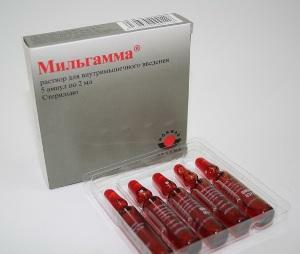
- reflexotherapy;
- stimulation of the nerve and muscle tissue( physiotherapy, neurostimulation, massage, exercise therapy);
- intake of B vitamins( Milgamma), C, E;
- reception of antiviral, anti-inflammatory drugs( Voltaren, Ketoprofen);
- use of homeopathic methods.
Operative methods include:
- neurolisis;
- stitching of the nerve trunk.
Consequences and complications of
The consequences of damage to the median nerve can be very serious: all three types( neuritis, neuropathy, neuralgia) belong to the category of frequently occurring and difficult to flow, which in neglected cases lead to complete or partial disability.
In case of insufficient treatment, or in the absence of such a patient, a person has to change his profession and lifestyle.
Numerous cases of disability acquired due to muscular atrophy, which is innervated by the affected nerve. Unfortunately, at the present time, a considerable number of errors are often allowed both in the diagnosis and in the treatment of this pathology.
Preventive measures
 In order to prevent the defeat of the internal popliteal nerve in time, avoid trauma, hypothermia.
In order to prevent the defeat of the internal popliteal nerve in time, avoid trauma, hypothermia.
It should be kept in mind that elderly people, sportsmen, as well as those who suffer from obesity( metabolic problems), have a predilection for alcohol and narcotic substances, lead an inactive way of life. You can avoid defeat even if you follow certain rules:
- is not to be in the squat position for a long time( especially it's worth remembering this to gather berries in the forest);
- in sitting position not to put a foot on foot;
- to lead a lively lifestyle;
- revise the diet( adhere to the regime of proper nutrition);
- to avoid infectious diseases( scarlet fever, HIV, tuberculosis, herpes, measles);
It is important that you timely seek qualified help at the first sign of a lesion. After all, most diseases are susceptible to conservative treatment at early detection.


